Have you ever thought about how to limit screen time for preschoolers without tantrums? Today, kids are glued to screens more than ever. This makes us wonder: can we teach them to use technology wisely from a young age?
It’s key to know how screens affect young kids. By setting the right limits, we can help them grow up with good habits. Finding a balance between fun, learning, and being active is the goal.
Key Takeaways
- Learning how to manage screen time for preschoolers without tantrums is essential for their healthy development
- Screen time management for kids requires setting age-appropriate limits and promoting physical activity
- Understanding the impact of screen time on young children is critical to promoting healthy habits
- Effective screen time management for kids involves finding a balance between entertainment, education, and physical activity
- By managing screen time for preschoolers, you can help your child develop essential skills and habits
- Screen time management for kids is an ongoing process that requires patience, consistency, and positive reinforcement
Understanding the Impact of Screen Time on Preschoolers
As a parent, it’s key to know how too much screen time affects your child. It can harm their body, mind, and behavior. Setting limits helps your preschooler learn good habits with screens.
Too much screen time can lead to a sedentary lifestyle. This might cause obesity and other health problems. It can also slow down language skills and make it hard to focus. It’s important to find a balance with other activities that help them grow.
To help your preschooler have healthy screen time habits, try these:
- Set a daily time limit for screen time
- Encourage physical activity and outdoor play
- Engage your child in interactive and educational screen time activities
Being careful about your child’s screen time is important. It helps them have a good relationship with screens. This way, they can avoid negative effects on their growth.
Recognizing Signs of Unhealthy Screen Time Habits
As a parent, it’s key to spot unhealthy screen time habits in your child. Reducing screen time for children is tough, but it’s vital for their health and growth. A sign is when your child wants to keep watching screens, even when it’s time to do other things.
If your child finds it hard to stop watching screens or prefers them over other fun activities, it’s a red flag. This could mean they have an unhealthy habit.
Another warning sign is if screen time messes with your child’s sleep, exercise, or social life. 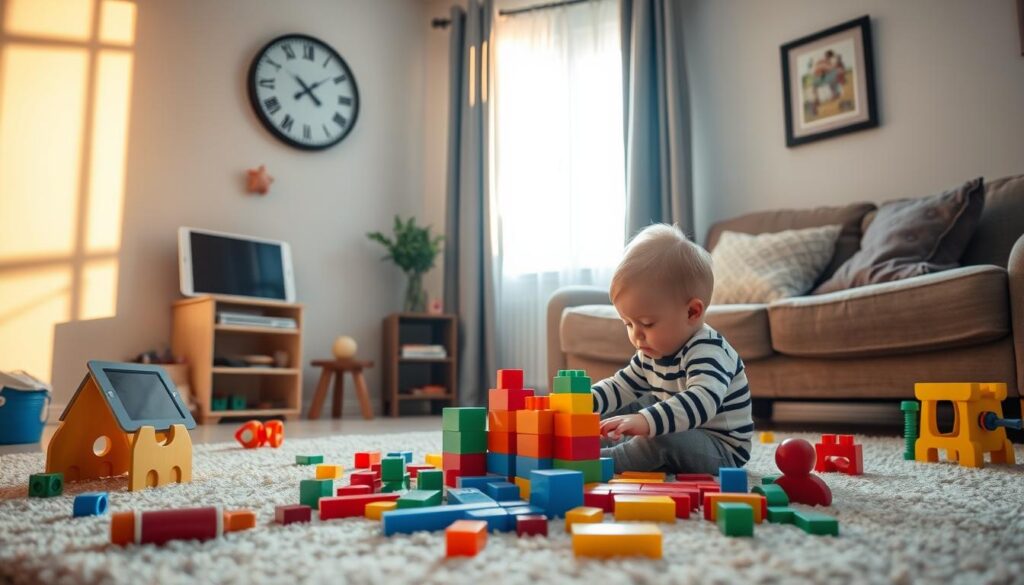 It’s important to notice these signs and act to balance their screen time. The American Academy of Pediatrics has screen time guidelines for toddlers and preschoolers. These guidelines can help you set limits and encourage good habits.
It’s important to notice these signs and act to balance their screen time. The American Academy of Pediatrics has screen time guidelines for toddlers and preschoolers. These guidelines can help you set limits and encourage good habits.
To spot unhealthy screen time habits, watch for these signs:
- Insistence on screen time
- Difficulty stopping screen use
- Preference for screens over other activities
- Affect on sleep, physical activity, or social interactions
By knowing these signs and taking steps, you can help your child develop healthy screen habits. This promotes a balanced lifestyle.
Setting Age-Appropriate Screen Time Limits
As a parent, you have a big role in balancing screen time for your preschooler. The American Academy of Pediatrics (AAP) offers guidelines for screen time by age. For preschoolers, focus on educational content and limit entertainment screen time.
Creating a weekly schedule for screen time is a good tip. It helps you and your child stay on track. Start by setting screen time for meals or before bed.
AAP Guidelines for Preschoolers
The AAP suggests limited screen time for preschoolers, focusing on educational content. Use this to plan a weekly schedule for your child. Allocate 30 minutes daily for educational content and 30 minutes for fun.
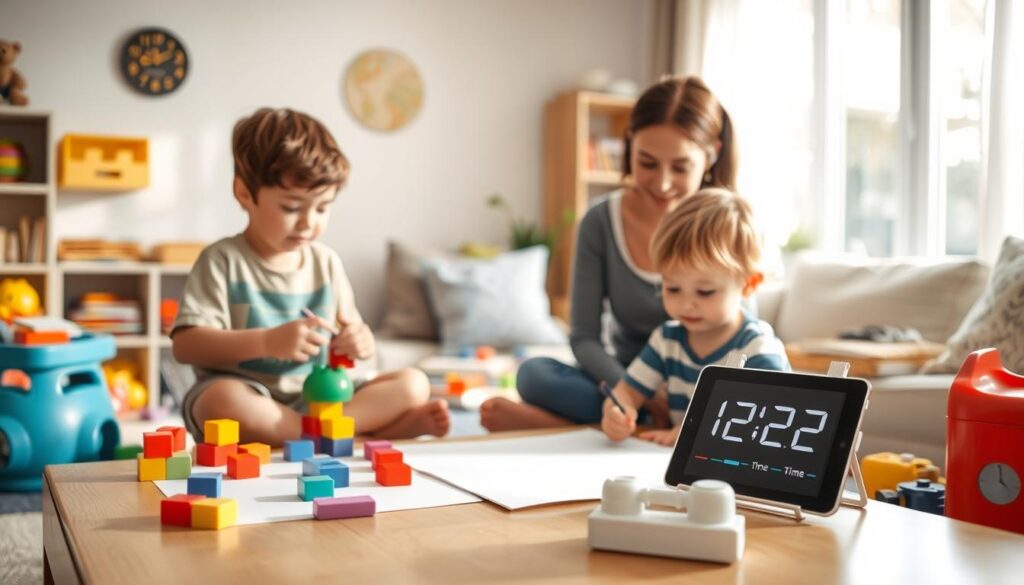
Creating a Weekly Screen Time Schedule
Having a schedule helps you and your child stay on track. Use a planner or app to make a schedule. Include times for screen use, physical activity, and outdoor play.
Balancing Entertainment and Educational Content
It’s key to mix entertainment and educational content for screen time. Allocate time for learning apps or educational videos. Also, set aside time for fun, like cartoons or games.
How to Manage Screen Time for Preschoolers Without Tantrums
As a parent, you want your child to have a good balance with screens. Learning how to manage screen time for preschoolers without tantrums is key. It’s about setting limits, giving alternatives, and being consistent. Start by explaining the reasons for limits in a way your child can grasp.
Offering other fun activities like outdoor play, reading, or puzzles can help. It’s important to be consistent with all caregivers about screen time rules. This way, you create a routine that helps your child develop good screen habits.
Some strategies for managing screen time for kids include:
- Creating a daily schedule that includes screen time and other activities
- Setting screen-free zones in the home, such as the dinner table or bedrooms
- Encouraging physical activity and outdoor play
By following these tips, you can help your child have a healthy relationship with screens. This way, they won’t throw tantrums when it’s time to turn off the device. Remember, it takes time and patience to learn how to manage screen time for preschoolers without tantrums. 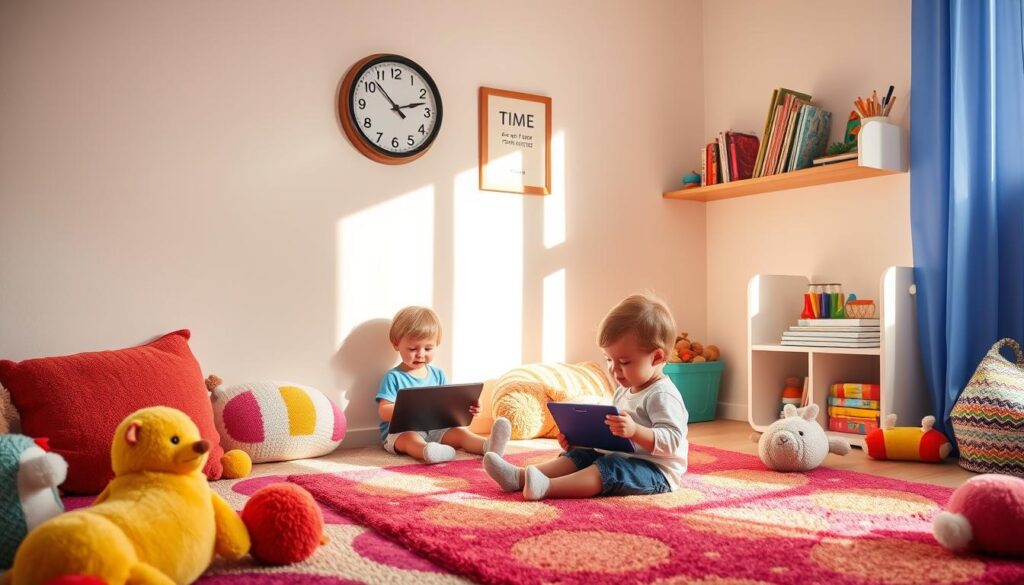
Preparing Your Home Environment for Success
To help your preschooler develop healthy screen time habits, you need to get your home ready. This means setting limits on screen time and making a space for fun, learning, and being active. This way, your child can learn to use screens wisely from a young age.
Designate areas in your home as screen-free, like the dinner table or bedrooms. Set up places for other fun activities, like art or reading. Also, keep devices in one spot to watch and control how much screen time your child has.
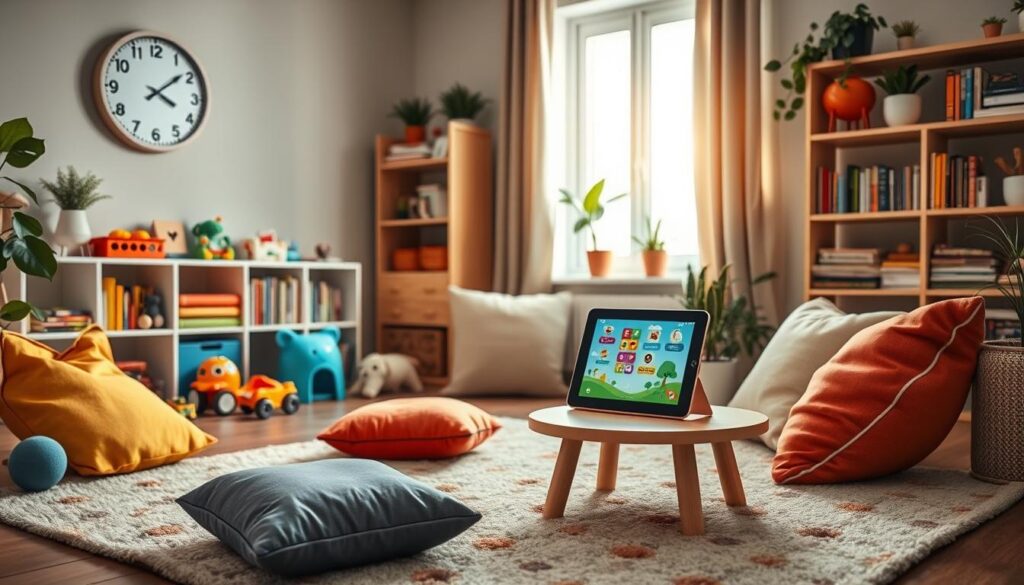
By doing these things, you help your child have good habits with screens and technology. Always watch over your child when they’re using screens. Join in on their activities to help them learn and make friends. With some planning, you can make your home a great place for your child to grow and learn.
Here are some more tips to help:
- Set a good example by limiting your own screen time
- Encourage physical activity and outdoor play
- Engage in activities with your child, such as reading, drawing, or puzzles
Establishing Clear Screen Time Rules and Boundaries
To manage screen time for kids, setting clear rules is key. This means setting screen times, approved content, and consequences for too much screen time. By reducing screen time for children, you help them develop good habits and avoid risks.
When making screen time guidelines for toddlers, think about their age and needs. Start with a daily limit and adjust as needed. It’s also important to set a good example, as kids learn from what they see.
Here are some tips for setting screen time rules:
- Set a daily time limit for screen use
- Create a list of approved content, such as educational apps and kid-friendly shows
- Decide on consequences for exceeding screen time limits, such as losing screen privileges for a day
- Establish screen-free zones, such as the dinner table or bedrooms
By following these tips and being consistent, you can help your children use screens wisely. Remember to update your screen time guidelines for toddlers often to keep them effective.
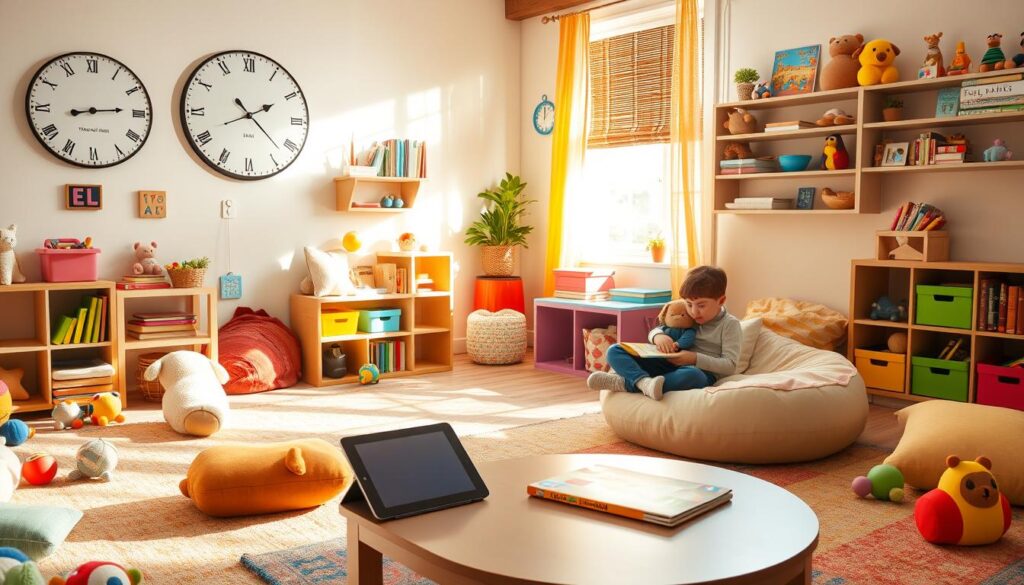
Setting screen time rules is a continuous effort. It takes patience and consistency. By working with your children and sticking to healthy screen habits, you help them succeed in a world full of screens.
Effective Communication Strategies for Screen Time Limits
Clear communication is vital for balanced screen time. As a parent, you shape your child’s screen time habits. By using effective strategies, you can teach your child about screen time limits and healthy habits.
Visual timers and schedules are great for communicating screen time limits. They show your child when they can use screens and when they can’t. For instance, you can make a daily schedule with screen time limits and other activities like outdoor play or reading. This helps your child manage their screen time and feel responsible.
Here are some tips for managing screen time for young kids:
- Set clear screen time limits and communicate them to your child
- Use visual timers and schedules to help your child understand screen time limits
- Implement a warning system before screen time ends to help your child prepare for the transition
- Offer positive reinforcement, such as praise or rewards, for staying within screen time limits
By following these tips, you can help your child develop good screen time habits. Always communicate clearly and be patient and supportive as they learn.
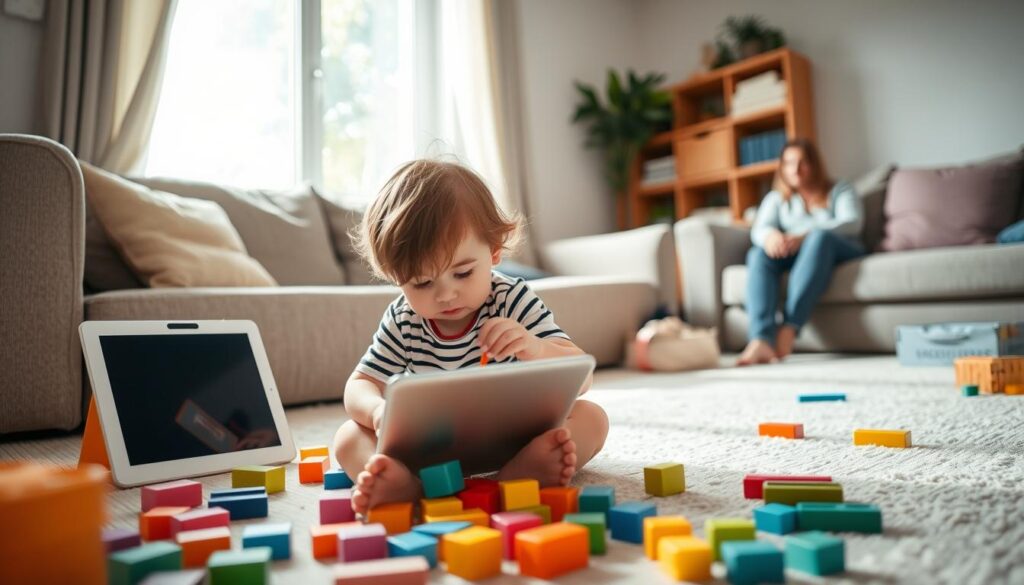
Engaging Alternatives to Screen Time
Finding fun and educational activities is key for screen time management for kids. These activities help your preschooler develop good habits and avoid tantrums. Letting your child help pick these activities makes them more excited to do them.
Outdoor play, arts and crafts, reading, and puzzles are great alternatives. They help with physical, cognitive, and emotional growth. For instance, outdoor play boosts motor skills, while reading improves language and literacy.
- Create a schedule for screen-free time
- Let your child pick an activity they like, like drawing or building blocks
- Join in on activities together, like playing a board game or going for a walk
By using these strategies and finding fun alternatives, you can help your child develop good habits. This reduces tantrums when it’s time to limit screen use. Learninghow to manage screen time for preschoolers without tantrumstakes time and effort. But with patience, consistency, and creativity, your child can thrive in a world full of screens.
Managing Special Situations and Exceptions
As a parent, setting limits on screen time is key for healthy habits in preschoolers. But, some times you need to bend the rules. This could be when traveling, on sick days, or at family gatherings. Having a plan for these times is vital.
For travel, pack toys and games that are easy to carry. On sick days, create a station with books and puzzles. At gatherings, plan activities without screens, like outdoor games or arts and crafts.
Here are more tips for handling special situations:
- Set clear expectations and communicate them to your child
- Offer alternative activities and distractions
- Be flexible and adapt to changing circumstances
Being ready and having a plan helps your child stay on track with healthy screen habits. Always remember to set limits and promote good screen habits for preschoolers.
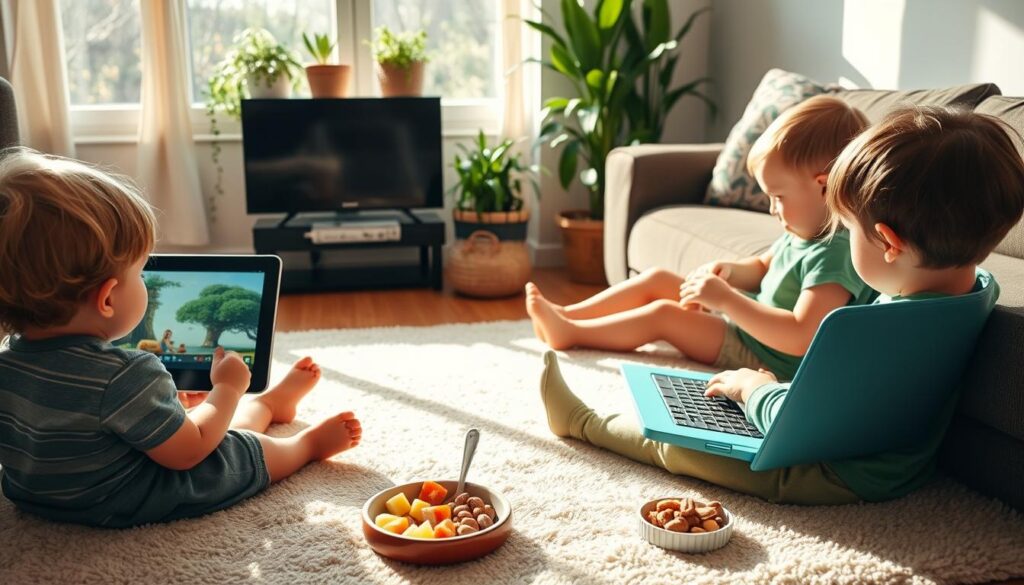
Building a Support System for Screen Time Management
Managing screen time for kids is easier with a strong support system. Talk to all caregivers, like family, babysitters, or nannies, about screen time rules. This way, everyone knows the rules and your child gets a clear message.
A support system gives you the motivation and ideas to stick to screen time rules. Start by identifying your goals and sharing them with your team. You might aim to limit screen time or make certain areas screen-free.
Here are some ways to build a support system:
- Join a community of parents with similar challenges
- Ask for help from family and friends
- Share your goals and updates with your team
Together, you and your support system can find new ways to cut down on screen time. Remember, it’s a journey that needs patience, consistency, and teamwork.
With the right support, you’ll feel more confident in changing your child’s screen time habits. So, don’t hesitate to build a support system that fits your family’s needs.
Addressing Common Screen Time Challenges
When you’re trying to balance screen time for your kids, you might face some obstacles. Peer pressure is a big one. Kids might feel left out if their friends get to use screens more. It’s key to talk openly about why balanced screen time is important.
Another challenge is keeping track of screen time across different devices. With so many devices around, it’s hard to monitor your child’s screen use. Setting device limits and using parental control software can help you stay on top of it.
Dealing with Peer Pressure
- Encourage open communication with your child about the risks of excessive screen time
- Set clear expectations and rules for screen time
- Offer alternative activities and hobbies to reduce reliance on screens
Managing Multiple Device Access
To handle multiple devices, consider using a centralized control system or software that tracks screen time. These steps can help your child use screens in a healthy way.
Conclusion
As you finish learning how to manage screen time for your preschooler, remember the importance of balance. By setting limits, making screen-free zones, and finding other fun activities, you can help your child use technology wisely. This way, they can enjoy screens without losing touch with the real world.
Every child is different, so what works for one might not work for another. Be ready to change your approach as your child grows. This flexibility will help your child develop important skills for the digital world while keeping them healthy.
Managing screen time for preschoolers is a journey, not a quick fix. With the right mindset and strategies, you can guide your child through the digital world confidently. Keep trying new things, adapting, and celebrating small wins. Your hard work will make a big difference in the long run.
